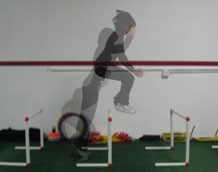 The definition of a plyometric exercise are exercises where they are generally considered to have a rapid eccentric (pre-stretch) contraction followed immediately by a quick concentric contraction (Shock Method). This is known the the stretch-shortening cycle and is explain further below. The reason we choose the term Reactive over Plyometrics is due to the fact that entry level plyometric exercises may not meet the definition due to utilizing proper progressions developing the required biomechanics to safely execute plyometric exercises and includes both Shock Method and Jump Training.
The definition of a plyometric exercise are exercises where they are generally considered to have a rapid eccentric (pre-stretch) contraction followed immediately by a quick concentric contraction (Shock Method). This is known the the stretch-shortening cycle and is explain further below. The reason we choose the term Reactive over Plyometrics is due to the fact that entry level plyometric exercises may not meet the definition due to utilizing proper progressions developing the required biomechanics to safely execute plyometric exercises and includes both Shock Method and Jump Training.
True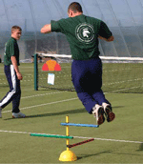 plyometrics was first developed by Verkhoshonski and other Soviet Block scientists and was referred to as Shock Method (Verkhoshonski, 1968). The term Plyometrics was first used in 1975 by Fred Wilt (American Track & Field Coach). Wilt interpreted plyometrics as exercises that produce “an overload of isometric-type muscle action which invoke the stretch reflex in muscle”.
plyometrics was first developed by Verkhoshonski and other Soviet Block scientists and was referred to as Shock Method (Verkhoshonski, 1968). The term Plyometrics was first used in 1975 by Fred Wilt (American Track & Field Coach). Wilt interpreted plyometrics as exercises that produce “an overload of isometric-type muscle action which invoke the stretch reflex in muscle”.
Some referred to Jump training as plyometrics which created further confusion as not all Jump training is plyometric in nature. In true (explosive) plyometrics the exercise must be executed as quickly as possible, in 0.15 to 0.2 seconds.
Even though Jump Training involve many of the same mechanisms as Plyometrics or Shock Method, they are very different in their effect on the body. For example, jump exercises involve the central nervous system (CNS) but not to the same extent as Plyometric exercises or Shock Method. In the latter case, the stress on the central nervous system is much greater and has a much more noticeable effect on the body. The eccentric strength component is also much less in Jump Training vs Plyometrics or Shock Method.
The term Reactive training does encompass plyometrics, utilizing the stretch-shortening cycle to enhance neuromuscular efficiency, rate of force production, and reduced neuromuscular inhibition along a continuum but this continuum also includes many techniques and principles.
Enhanced performance during functional activities emphasizes the ability of the muscles to exert maximal force output in a minimal amount of time (rate of force production). Reactive training allows you to train this ability specifically while in a controlled environment reducing injury potential in training and even during the individual maybe involved with.
Reactive Training heightens the excitability of the central nervous system, which can improve performance when implemented with the right training program and recovery.
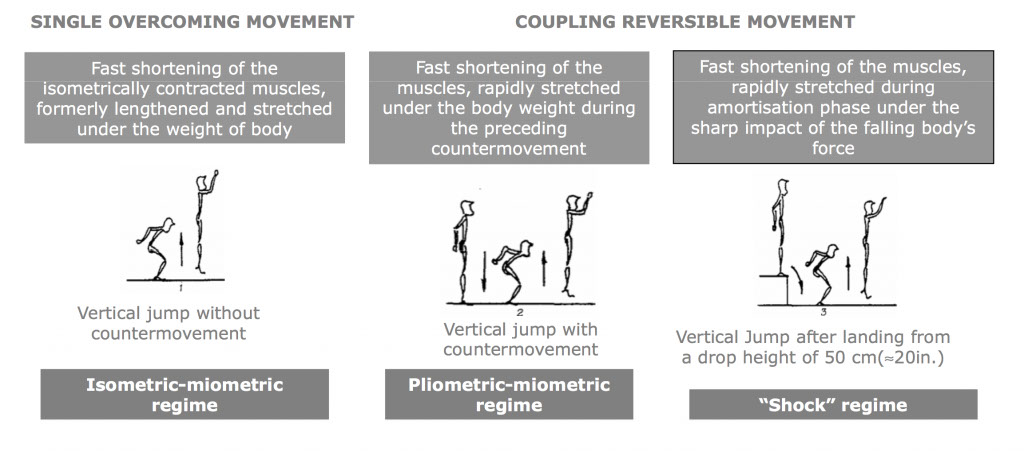
Reactive training is important for every client, not just the athlete. The concepts of training do not change when applying reactive training to the general population only the application of the concept.
For example, if a 75 year person steps off from a curb and loses their balance, they had better have worked on rate of force production so that they can re-establish their base of support under their rapidly changing center of gravity.
Purposes of Reactive Training
- Enhance the excitability, sensitivity and reactivity of the neuromuscular system
- Enhance the rate of force production
- Increase motor-unit recruitment
- Increase motor-unit firing frequency
- Increase motor-unit synchronization
Interaction of SEC, PEC, and CC
- SEC: Series Elastic Component.
- CC: Contractile Component
- PEC: Parallel Elastic Component.
Concentric Contraction
- CC responsible for shortening muscle
- As muscle continues to shorten, stretch is applied to SEC
Eccentric Activity
- CC, SEC, and PEC produce force
- SEC and PEC resist movement as muscle elongates
- CC controls speed and quality of movement
- Less force required
- Less energy used in eccentric
Neurological Components
- Stimulation of proprioceptors and Muscle spindles
- Golgi Tendon Organ’s (GTO’s)
Phases of the Stretch-Shortening Cycle
Understanding the basics and terminology of the stretch-shortening cycle is important to be able to principles and then coach those principles using the methods here.
The term “stretch shortening cycle” is the most commonly used and perhaps most appropriate description of reactive or plyometric exercises.
Phase I (eccentric phase)- stretching the agonist muscle group(s)
- Elastic energy is stored
- Muscle spindles fire
Phase II (amortization phase)- time needed to switch from an eccentric to a concentric action
- Afferent nerves synapse with alpha motor neurons
- Alpha motor neurons transmit signal to agonist muscle group
Phase III (concentric phase)- agonist muscle fibers contract
- Elastic energy is released from the series elastic component
- Alpha motor neurons stimulate the agonist muscle group
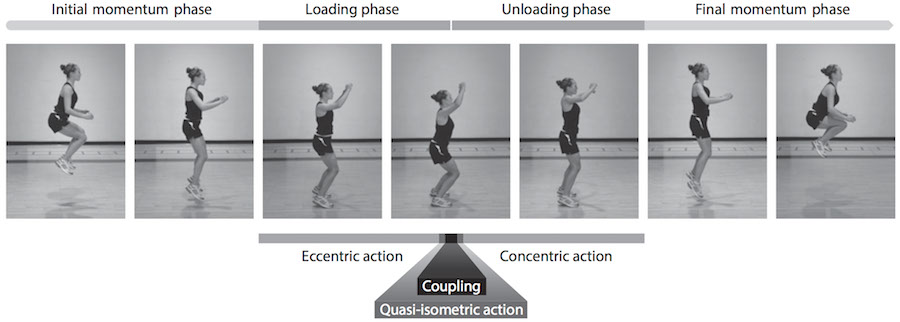
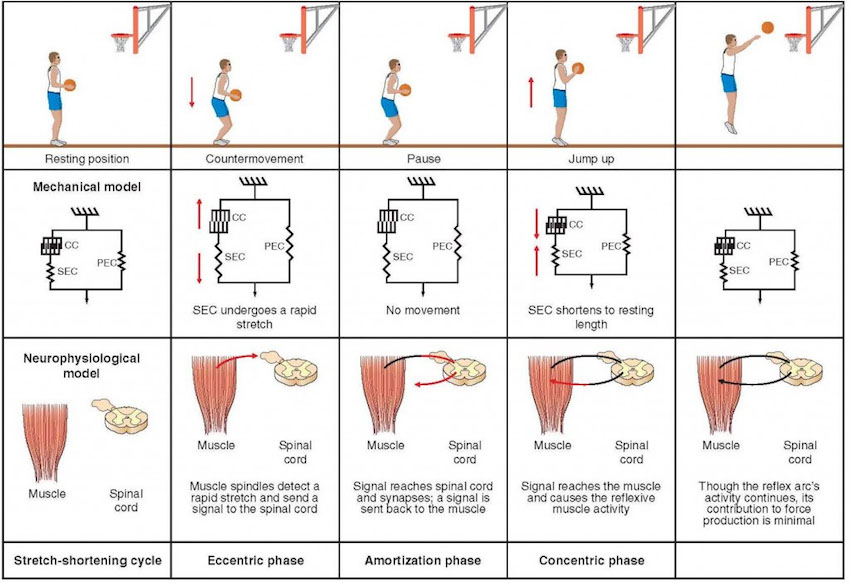
Misinformation on Reactive Training
You may find that some information that is presented on reactive training (plyometrics) is actually incorrect and often based only on what others have stated over the year rather than real facts. Here are a few you may hear:
- You must be able to squat 2 x bodyweight.
- Kids should not do reactive training (plyometrics).
- You should not perform reactive training (plyometrics) everyday.
You must be able to squat 2 x bodyweight
The story goes that this was taken out of context in a lecture and somehow became a fact. Nothing further could be from the truth especially is you actually use some logic and look at what is being stated. A 55kg woman should only utilize reactive training only once they are able to squat a load of 110kg. How many non-powerlifting 55kg women are squatting 110kg? Just remember its about progression and there in not scientific basis for this rule.
Kids should not do reactive training
This one again makes no sense as what do you think kids do all day in they playground? Maybe not in some countries where play and physical education has been downplayed however for others you can just look at kids play is see the involvement of these reactive forces.
You should not perform reactive training everyday
This one on the surface may sound like it would be true however when it comes to reactive training its about frequency and not volume. Meaning you want lower volume reactive work performed more frequently. This is due the the potential stressors on the tissue produced when using higher volume training.
General Guidelines on Reactive Training
- Linear Bounds may only be necessary for track athletes (may cause SI or foot pain). Lateral Bounds may still be used.
- Frequency not volume is the key.
- The larger the individual the smaller the obstacle.
- Don’t use jump ropes as Reactive Training– far too repetitive.
- Listen to landing – loud means that joints take the loading, quiet means the muscles are taking the loading.
